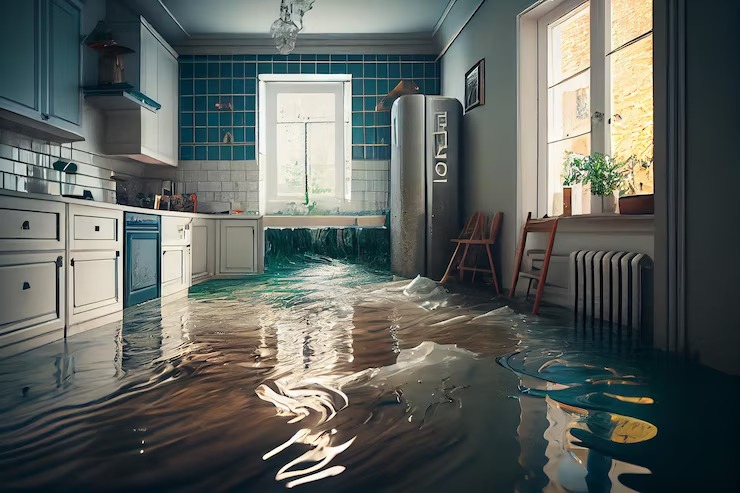Water damage is one of the most common — and most expensive — issues homeowners face. It can happen gradually from a small leak or suddenly from a burst pipe, flood, or roof failure. In both cases, the results can be devastating: ruined floors and walls, mold growth, structural issues, and expensive repairs.
Fortunately, most water damage is preventable. In this in-depth guide, we’ll explore how to protect your home from water damage with practical tips, smart technologies, seasonal checklists, and long-term maintenance advice. Whether you’re a new homeowner or a seasoned one, these strategies can help you save thousands and avoid the stress of unexpected repairs.
1. Know the Common Sources of Water Damage
1.1. Plumbing Failures
- Leaky pipes
- Frozen pipes bursting
- Worn-out washers or valves
- Toilet overflows
1.2. Appliance Malfunctions
- Washing machines and dishwashers
- Water heaters
- Refrigerators with ice makers
1.3. Roof Leaks
- Damaged shingles or flashing
- Clogged gutters and downspouts
- Ice dams in winter
1.4. Basement Flooding
- Poor grading around the house
- Cracks in the foundation
- Failed sump pumps
1.5. External Causes
- Flash floods
- Heavy rainfall
- Sewer backups
2. Perform Regular Inspections
2.1. Inspect Plumbing Twice a Year
Check under sinks, around toilets, and behind appliances. Look for signs of corrosion, leaks, or water stains.
2.2. Examine the Roof Annually
Use binoculars or a drone, or hire a roofer to inspect for missing shingles, loose flashing, or ponding water.
2.3. Test Sump Pumps
Pour water into your sump pit to ensure the pump activates and drains properly. Replace old units every 7–10 years.
2.4. Check Gutters & Downspouts
Clear leaves and debris regularly. Ensure water flows away from the foundation.
3. Upgrade to Smart Water Technology
3.1. Install Smart Leak Detectors
Place under sinks, behind appliances, and near water heaters. Devices like Flo by Moen or Honeywell Water Leak Detectors send alerts to your phone.
3.2. Automatic Water Shut-Off Valves
Systems like Phyn Plus or Flo can detect unusual flow and shut off water automatically, preventing major damage.
3.3. Water Usage Monitoring
Track water usage patterns to catch leaks early and conserve water.
4. Prevent Basement & Foundation Issues
4.1. Ensure Proper Grading
Soil should slope away from your house, not toward it.
4.2. Waterproof the Basement
Apply sealants to walls and floors, and install a vapor barrier.
4.3. Extend Downspouts
Direct water at least 4–6 feet away from your home’s foundation.
4.4. Install Drain Tiles or French Drains
These systems redirect water before it reaches your foundation.
5. Roof & Gutter Maintenance
5.1. Clean Gutters Seasonally
Prevent overflow that can damage siding, soffits, and basement walls.
5.2. Inspect Flashing & Chimneys
These are common leak points. Seal or replace damaged areas.
5.3. Use Gutter Guards
These prevent clogs and reduce how often you need to clean gutters.
6. Appliance Maintenance
6.1. Replace Old Hoses
Rubber hoses on washing machines can rupture. Replace with braided stainless steel.
6.2. Check Seals and Connectors
Ensure dishwasher and fridge water lines are tightly connected and not cracked.
6.3. Drain Water Heaters Annually
Flush sediment buildup to prevent leaks and extend life.
7. Bathroom and Kitchen Tips
7.1. Seal Grout & Caulk
Inspect and reseal around tubs, sinks, and backsplashes to prevent water seepage.
7.2. Use Exhaust Fans
Vent moisture to reduce condensation and mold risk.
7.3. Install Water-Resistant Materials
Choose waterproof flooring and wall coverings in wet zones.
8. Seasonal Checklist for Water Damage Prevention
Spring
- Check for roof damage after winter
- Test sump pumps
- Clear out gutters
Summer
- Look for signs of moisture in crawlspaces
- Inspect plumbing in unused bathrooms or basements
Fall
- Clean gutters before leaf buildup
- Check window and door seals
Winter
- Insulate exposed pipes
- Remove snow from roof edges
- Let faucets drip during freezing temps
9. What to Do If You Discover a Leak
- Shut off the water supply.
- Remove excess water with towels or a wet/dry vacuum.
- Use fans or dehumidifiers to dry the area.
- Call a restoration professional to inspect for hidden damage.
- Document the issue for insurance purposes.
10. Why Professional Help Matters
Fast Dry-Out Services
Companies like Elite Restorations use industrial fans and dehumidifiers to dry your home quickly and prevent mold.
Damage Assessment
We check behind walls, under floors, and inside ceilings to find moisture you can’t see.
Mold Prevention
We treat surfaces with antimicrobials and recommend long-term solutions.
Insurance Help
We document damage, assist with claims, and help you get reimbursed.
Final Thoughts
Water damage doesn’t wait — and it often strikes when least expected. But with proactive maintenance, smart devices, and seasonal awareness, you can dramatically reduce the risk.
If you ever find yourself facing water damage, Elite Restorations is here to respond 24/7 with trusted, professional restoration services.




